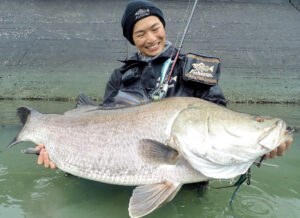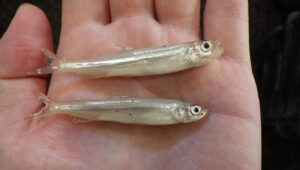Fishing with shrimp live bait in the most lively city in Japan
If you visit Tokyo and Osaka, you may feel that the atmosphere in Osaka is more active and open, or the city appears more lively. Then, your feeling is right as Japanese people think about what kind of atmosphere the Osaka or Kansai region have. It is said that Osaka had been the city of commerce, and this business attitude led them to have such an mentality.
For angling, this may be true in the salt water there, too, because they often use live shrimps for chumming.
It is quite candid reasoning that, to have the best result in the shortest time, the live bait should work best. Fish must love the lively thing better than dead ones. It looks like business, to me, but Kansai people’s heart calls for it.
Many anglers in the Kansai region, backed up with their mentality and reasoning, go fishing with live shrimp.
In this article, you will see the details of this fishing and will go a little deeper about the reasons for its population.
Ebi-maki method
In Japanese, ebi is the word for shrimps in general. And it is combined with another word that means to spread, maki, to have a word meaning this style of fishing, Ebi-maki fishing.
As long as you spread or chum live shrimp to catch fish, it can be called Ebi-maki, but the most popular style is to fish with floats.
The rig is using the light Iso fishing (the Rocky coast fishing) rod, with the spinning reel of 2000 to 3000 size. (about Iso fishing, you can find more information in an article of mine.)
Rig is quite simple. One of the important points is to use the thin and long float (of about 30 to 60 cm).
We use the shrimp called shirasa-ebi or suji-ebi (Lake prawn, Palaemon paucidens).
And the shrimp is hooked like below, to let it sink in natural posture. Actually, it varies depending on anglers. Some are putting the hook near the tail.
After you are ready, you start to chum with the live shrimps. Fishing stores around the region are holding the livestock of this shrimp, and you can buy them easily.
Reflecting the popularity of this fishing, we have the special spoons to scoop the shrimp and cast away.
After you cast several cups of shrimps, you cast your rig to let the hooked bait sink with the chum. Since this ebi-maki style is done in the areas deep inside the bay, the water often does not move fast. Even so, you need to read the flow of the water well. And there must be a little strategy to cast the live shrimp and to place your rig.
Of course, the live shrimp is very effective to attract fish. Using the thin and long float, it can give you much information about the situation in the water.
The depth range or the length under the float til the bait normally starts with 3 to 4 m, and while you search any actions, you make the searching depth deeper.
Now, please imagine that you throw shrimps alive, and what will they do then? They will start to swim around while sinking. Here, the live baits may swim away somewhere else, by the time they reach at the targeted depth.
To deal with this problem, anglers had come up with two solutions.
One is to stop the movement of shrimps temporarily. Anglers shake the spoon with shrimp, placing one hand over the cup. It gives a shock to shrimps and they hold their movements for a while.
Another solution is to release the shrimps at the targeted depth, using a special device. This is a small sphere shaped basket that is made to open in half when jerked.
You can view how it works in this video.
Now, you can target fish of any depth with this ebi-maki fishing.
With this, you can catch bottom fish as well as fish swims pelagically.
Why Osaka?
This ebi-maki fishing is not popular in other parts of Japan. Firstly, in the other area, fishing shops do not stock the live shrimps, as much as shops in Osaka. This shrimp is sold as a hooked bait, but most of the shops sell them in smaller amounts.
One of the reasons for this is that most of the shrimp bait sold in Osaka is coming from Lake Biwa, the biggest freshwater lake in Japan.
Lake Biwa is located about 50 km away from Osaka. It enabled the delivery of this shrimp alive, from the lake to Osaka.
Around 1980’s and the first half of 1990’s, the amount of shrimps taken from Lake Biwa was much higher than current level (below graph).
As the amount was decreasing, shrimps came to be brought from other regions, including overseas, as well as domestic. (Note: the import of this specific shrimp is stopped for the quarantine reason.)
History of ebi-maki fishing
This way of fishing should have been done for a long time. There are not much historical records. But, the bait was easier to get and people were there trying to catch fish, and naturally they must have developed a method similar to ebi-maki fishing.
I assume this ebi-maki fishing started gaining popularity in the 1980's. In this period, along with the increase of shrimp production, many of the piers were developed along the coast of Osaka bay.
With the booming economy, people found pleasure in leisure fishing, and came to spend more money on fishing. Some enthusiasts were spending more money to buy the rather expensive, but still available, live shrimps. Since they had very good results, this method came to be one of the most popular methods.
In Japan, there is a proverb,
“You can catch a red seabream, if you use shrimps.”
It tells us that you spend some money and you can get a big reward. Small but some additional investment can make a big difference in the result.
This is exactly what Osaka fishermans did, in fishing, and they invented ebi-maki fishing.
It may be just a coincidence that the commercial mentality was in people in Osaka and it allowed them to start this fishing. Nobody knows the truth.
Anyway, such a phenomenon tells us how deeply fishing or angling is in Japanese people’s mind!

